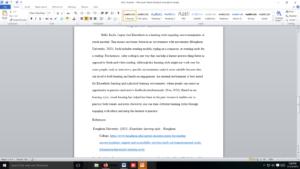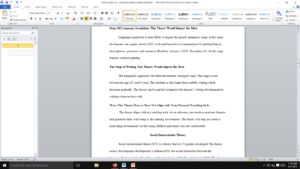Success and School
Prior to beginning this activity, read Chapter 12: School, Work, and Leisure,
In this reflection,
- Identify and explain key points throughout out your lifespan (childhood, adolescence, and adulthood) that have left an impression on your beliefs about receiving an education.
- Include at least three experiences: one in childhood, one as a teen, and one as an adult.
- Identify what led to the events and what effects each event has had on your academic journey or beliefs about earning a degree.
- Identify factors suggested to be effectors of development, by your weekly reading that align with your experiences (i.e., childcare, preparedness, learning environment). Share only information that you are comfortable with, or you may use another’s experiences or a fictitious example.
- To successfully do this, add proper citations throughout your writing.
Your journal, this week, should be 400 to 500 words and have an introduction and a conclusion
You should exhibit obvious attention to critical thought and understanding of the content, as demonstrated in Samantha Agoos’s TED-Ed Animation, 5 Tips to Improve Your Critical Thinking (Links to an external site.). You should include citations as needed to support your ideas. As this is your personal reflection about the material this week, your journal should limit the use of quoted material. Proper grammar should be applied,
At a minimum, cite your text to support your assertions within your explanation, but you may also use additional scholarly sources.
Shriner, B., & Shriner, M. (2014). Essentials of lifespan development: A topical approach. Bridgepoint Education.
Requirements: 500 words
Answer preview
As I go through college, I already have a sense of identity and am ready to share my life with others. As people go through many challenges in early adulthood, like relationships and intimacy, those with no self-identity feel loneliness and emotional isolation. For example, I got in a relationship that didn’t go according to my Christian and school knowledge, and I ended up breaking up maturely. Factors that affected my growth development include the environment I learned through, the exercises, controlling my emotions, and my genes, which were good enough to know what’s right and wrong.
[653 Words]

Success and School



